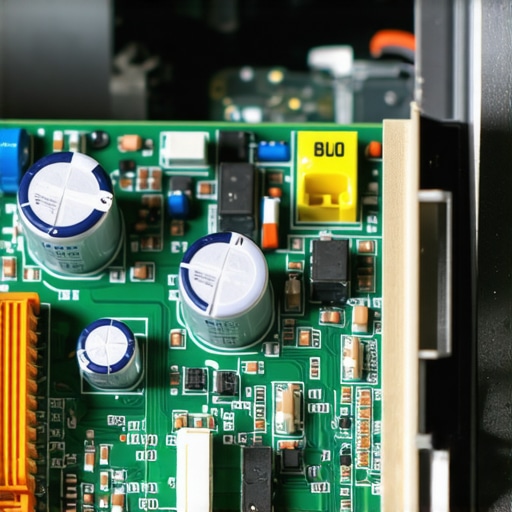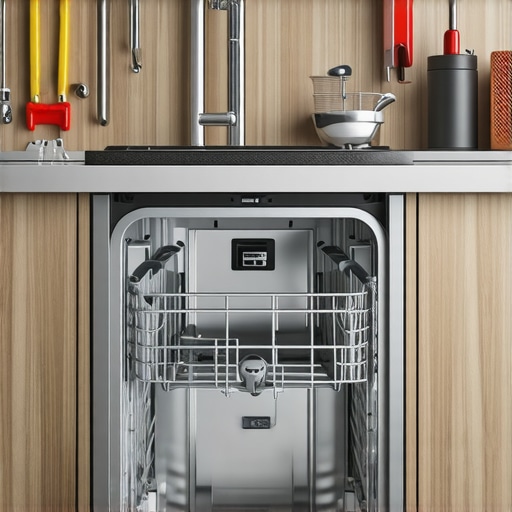How a Simple Malfunction Turned into a Personal Learning Experience
It was a hectic Monday morning when my dishwasher suddenly refused to drain, leaving me puzzled and a bit frustrated. As someone who loves DIY repairs, I decided to dive into troubleshooting instead of calling a technician. That first experience sparked my curiosity about how dishwashers work and what common issues might pop up. Over time, I’ve gathered some invaluable insights that I’d love to share with fellow homeowners facing similar frustrations.
Understanding My Dishwasher’s Heart: The Importance of Diagnostics
Initially, I realized that diagnosing a dishwasher problem isn’t as daunting as it seems. It’s about understanding the core components—like the pump, filter, and drain hose—and knowing what symptoms point to which part. For example, if your dishwasher isn’t draining, it could be a clogged filter or a faulty drain pump. I learned to listen carefully to any unusual noises and observe water levels after cycles, which helped me narrow down the cause. For more detailed troubleshooting steps, I found this guide on diagnostic tips incredibly helpful.
Why Replacing Parts Often Solves the Issue
One thing I discovered is that many dishwasher problems are surprisingly simple fixes—like replacing a worn-out door latch or a defective float switch. When I replaced my dishwasher’s float switch, it immediately resolved the water level issue. I recommend keeping a stock of essential parts such as replacement filters, door seals, and spray arms. Knowing where to find quality parts, like those listed here, makes DIY repairs much less stressful and more successful.
What’s the Secret to Quick and Reliable Repairs?
From my experience, the key is proper diagnostics combined with quality replacement parts. I always double-check the part compatibility before installation and follow manufacturer instructions carefully. Sometimes, a thorough cleaning of components like the spray arms and filters can restore functionality without needing to replace parts. For more insights into quick fixes, I recommend reading this repair guide.
Ever Wondered Why Your Dishwasher Keeps Breaking Down?
Many issues stem from overlooked causes, like mineral buildup or improper loading. Regular maintenance, such as cleaning filters and checking hoses, can extend the lifespan of your appliance significantly. Additionally, consulting authoritative sources, like appliance repair experts, can prevent costly replacements down the line. For comprehensive repair knowledge, I often reference trusted sites like the Energy Department’s tips on dishwasher maintenance.
If you’ve faced similar problems or have your own troubleshooting stories, I’d love to hear your experiences! Sharing practical tips can help others save time and money. Feel free to comment below or explore more repair guides to empower yourself in maintaining household appliances.
The Role of Water Flow and Drainage in Dishwasher Reliability
As I delved deeper into troubleshooting, I realized that understanding the water flow cycle is crucial. When a dishwasher fails to drain or fills improperly, the culprit often lies within the drain pump, clogged filters, or faulty sensors. Regularly inspecting these components can prevent minor issues from escalating. For instance, a blocked filter not only hampers drainage but also causes water to recirculate, leading to poor cleaning results. To master this aspect, I recommend reviewing comprehensive guides like this resource which offers detailed diagnostics on water flow issues.
Exploring the Hidden Causes of Dishwasher Failures
Beyond the obvious mechanical parts, many problems are caused by less apparent factors such as mineral deposits, electrical issues, or even improper loading. Mineral buildup, especially in areas with hard water, can clog spray arms or sensors, reducing efficiency. Electrical faults, like worn-out wiring or failing control boards, require careful testing using multimeters and following safety protocols. Proper loading techniques also matter; overloading can block spray arms or strain components, leading to premature failure. For a nuanced understanding, professionals often consult trusted sources such as the Energy Department’s maintenance tips.
Creative Troubleshooting Techniques Every DIY Enthusiast Should Know
Sometimes, troubleshooting calls for creative solutions. For example, when water doesn’t drain, I’ve found that manually rotating the drain pump impeller can reveal obstructions missed during routine inspections. Using a flexible brush or a long toothpick can dislodge debris lodged in small passages. Additionally, running a diagnostic cycle—if your model supports it—can highlight error codes that point directly to the failing component. For detailed step-by-step procedures, I recommend exploring this troubleshooting guide for quick diagnostics.
What Are the Subtle Signs That Indicate a Major Dishwasher Breakdown is Near?
Many homeowners overlook subtle signs that hint at a looming failure. Unusual noises during operation, inconsistent cleaning, or water remaining at the bottom after a cycle are often early warnings. Persistent leaks or an increase in cycle times can also signal worn-out seals or motor issues. Recognizing these signs early allows for targeted repairs, saving time and money in the long run. For instance, inspecting and replacing worn door seals can prevent leaks and water damage. To improve your diagnostic skills, consider reading more about key repair parts and troubleshooting tips at this comprehensive repair resource.
If you’ve encountered unique dishwasher problems or have innovative troubleshooting tips, I invite you to share your experiences in the comments. Your insights can help fellow homeowners tackle appliance issues more confidently and effectively. Don’t forget to explore additional repair guides to empower your DIY skills and extend the lifespan of your household appliances.
Uncovering the Subtle Signs of an Impending Dishwasher Breakdown
Over the years of repairing my dishwasher, I’ve come to recognize that many signs of trouble are more nuanced than they seem at first glance. For instance, I noticed that a slight increase in cycle times or occasional pauses during operation often precede major failures. These subtle cues, like a faint whining noise or a slight leak, prompted me to investigate further rather than dismiss them as minor glitches. Recognizing these early warning signs can be a game-changer, allowing for timely intervention that saves both money and frustration. For those interested in mastering this skill, exploring detailed diagnostics and understanding the behavioral patterns of your appliance can make all the difference.
What Are the Hidden Complexities Behind Common Dishwasher Failures?
Many homeowners assume that dishwasher issues are purely mechanical, but in reality, electrical and sensor-related problems are just as common—if not more so. For example, a malfunctioning control board or worn-out sensors can cause erratic behavior, such as incomplete cycles or improper water filling. These issues are often overlooked because they aren’t visible during routine inspections. I learned that testing electrical components with a multimeter, following safety protocols, and understanding wiring diagrams are essential skills for advanced troubleshooting. This deeper dive into the electronic side of dishwashers has empowered me to identify problems that might otherwise be mistaken for simple mechanical failures. For further insights, I recommend reviewing resources like this comprehensive guide.
How Do Water Flow Dynamics Influence Long-Term Dishwasher Reliability?
Understanding water flow is crucial, especially when dealing with persistent drainage or cleaning issues. I found that even minor mineral deposits or debris in the spray arms or filters can disrupt the delicate balance of water pressure and flow. Over time, these obstructions gradually diminish cleaning efficiency and increase wear on components like the pump and sensors. Regularly inspecting and cleaning these parts, combined with descaling in hard water areas, can significantly extend your dishwasher’s lifespan. I’ve learned that paying attention to the water flow cycle’s intricacies—such as the timing and pressure at each stage—can help diagnose problems before they escalate. For a detailed exploration of water flow diagnostics, check out this resource.
Can Creative Diagnostic Techniques Save You Time and Money?
Absolutely. Sometimes, the most effective troubleshooting methods involve thinking outside the box. For example, I once manually rotated the drain pump impeller to dislodge an obstruction that wasn’t visible during a standard inspection. Using flexible tools like long brushes or even a piece of wire can reveal hidden debris lodged in tiny passages. Additionally, running diagnostic cycles—if your model supports it—can generate error codes that point directly to the failing component, saving you hours of guesswork. Developing these creative strategies has allowed me to fix issues faster and with greater confidence, especially when DIY repairs are concerned. For detailed step-by-step techniques, I recommend exploring this troubleshooting guide.
What Are the Nuanced Signs Indicating a Major Dishwasher Failure Is Imminent?
Unusual noises, inconsistent cleaning, and water remaining at the bottom after cycles are early signals that something isn’t right. However, I’ve found that persistent leaks or a sudden increase in cycle duration often point to worn-out seals or motor issues. Recognizing these signs early requires attentive listening and careful inspection of seals, hoses, and the motor assembly. Replacing worn door seals or checking for mineral buildup can prevent water damage and costly repairs down the line. To hone your diagnostic skills, I suggest reviewing trusted sources like this expert resource. Sharing your own experiences with subtle signs can also help others develop a keener eye for potential failures.
If you’ve encountered unique dishwasher problems or have innovative troubleshooting tips, I invite you to share your stories in the comments. Your insights not only help fellow homeowners but also enrich the collective knowledge of DIY repair enthusiasts. Remember, the key to successful repairs lies in continuous learning and curiosity—so keep exploring and experimenting with your appliances!
Mastering the Electronic Heart: Diagnosing Control Board and Sensor Anomalies
Delving into the electronic intricacies of dishwashers reveals a realm where subtle faults can cause major disruptions. A malfunctioning control board or defective sensors often mimic mechanical failures, but require a diagnostic approach rooted in electronics expertise. Using a multimeter to test voltage outputs or inspecting wiring diagrams—resources available from detailed guides like this authoritative source—can pinpoint issues that elude basic troubleshooting. Recognizing intermittent signals or erratic error codes during diagnostic cycles is crucial for advanced repairs. This electronic detective work enhances my ability to resolve complex failures swiftly, saving time and costly replacements.
Why Mineral Deposits and Hard Water Are the Silent Killers
Mineral buildup, especially in hard water regions, silently undermines dishwasher performance. Deposits can occlude spray arms, clog sensors, and corrode internal components over time. Regular descaling with specialized solutions, like those recommended by industry experts, is essential—not just for cleaning but for maintaining optimal water flow dynamics. I’ve learned that incorporating preventative descaling routines—aligned with the hardness of local water—is a game-changer. These deposits are often overlooked culprits behind persistent poor cleaning or drainage failures, and their removal restores efficiency and extends appliance lifespan. For tailored advice, I consult trusted maintenance tips frequently.

Unraveling Complex Water Flow Dynamics for Long-Term Reliability
Understanding the water flow cycle’s nuances—pressure, timing, and distribution—is fundamental for diagnosing persistent drainage and cleaning issues. Even minor obstructions or incorrect loading can disrupt this delicate balance, causing premature wear. I’ve adopted a habit of monitoring cycle stages, noting abnormal pressure drops or delays, which often indicate clogged filters or partially obstructed spray arms. Mastery over these flow dynamics enables targeted interventions before catastrophic failures occur. For a comprehensive understanding, I recommend exploring this detailed resource on water flow diagnostics, which has been instrumental in my DIY toolkit.
Can Creative Diagnostic Techniques Reveal Hidden Failures?
Absolutely. Thinking creatively can uncover hidden issues that standard checks might miss. For instance, manually rotating the drain pump impeller during diagnostics can reveal obstructions lodged in tiny passages. Using flexible tools like long brushes or even a piece of wire can dislodge debris, restoring flow. Running model-specific diagnostic cycles often generates error codes, guiding precise repairs. These techniques, honed through hands-on experience, save countless hours and prevent unnecessary part replacements. For step-by-step guidance, I turn to this troubleshooting guide, which continually expands my problem-solving arsenal.
What Subtle Signs Foretell a Major Dishwasher Breakdown?
Early warning signs—such as unusual noises, inconsistent cleaning, or water pooling—are often dismissed but can signal imminent failure. Persistent leaks or increased cycle duration are more overt indicators of worn-out seals or failing motors. Recognizing these signs early allows for targeted interventions, like replacing worn door seals or inspecting electrical connections. Developing an eye for these nuances has been invaluable—saving me from costly repairs down the line. To refine this diagnostic skill, I consult trusted sources like this expert guide. Sharing your own experiences with subtle cues can help foster a community of informed DIY enthusiasts.
If you’ve encountered complex issues not covered here or have innovative troubleshooting methods, I invite you to share your insights. Your stories enrich our collective knowledge and empower others to approach repairs with confidence. Remember, mastering these advanced diagnostics is an ongoing journey—keep exploring, experimenting, and learning from each repair experience to become a true appliance troubleshooting expert!
Things I Wish I Knew Earlier (or You Might Find Surprising)
1. The Power of Regular Maintenance
One of the biggest lessons I learned is that consistent upkeep, like cleaning filters and descaling, can prevent most major issues. I used to ignore these small tasks, only to face costly repairs later. Now, I see maintenance as a way to extend my dishwasher’s lifespan and keep it running smoothly.
2. Listening to Unusual Noises Can Save You Money
At first, I dismissed odd sounds as normal, but I later realized they often signal something amiss—like a worn-out pump or debris lodged in the spray arms. Paying attention to these subtle cues can help catch problems early before they become expensive fixes.
3. DIY Parts Replacement Is More Accessible Than You Think
I was intimidated at first about replacing parts myself, but with the right guides and quality replacement components, I’ve successfully fixed issues like faulty float switches and door seals. It’s empowering and saves a lot of money.
4. Hard Water Is a Silent Enemy
Living in a hard water area, I noticed mineral deposits clogging spray arms and sensors. Regular descaling and using water softeners made a noticeable difference in performance and durability.
5. Proper Loading Matters More Than You Think
Overloading the dishwasher can block spray arms and cause incomplete cleaning. Learning correct loading techniques has improved my results and reduced strain on parts.
Resources I’ve Come to Trust Over Time
- Energy Department’s Tips on Dishwasher Maintenance: This site offers comprehensive advice on preventive care, which I find invaluable for avoiding issues before they start.
- Appliance Repair Forums: Real-world experiences and troubleshooting tips shared by fellow DIY enthusiasts have guided many of my repairs.
- Manufacturer’s Repair Guides: These official resources help ensure I use correct procedures and parts, making repairs safer and more effective.
Parting Thoughts from My Perspective
Reflecting on my journey with dishwasher repairs, I realize that a bit of knowledge and a proactive attitude go a long way. Regular maintenance, paying attention to early signs of trouble, and knowing where to find reliable parts and guides have transformed my approach from reactive to preventive. If this resonates with you, I’d love to hear your own stories or tips. Sharing our experiences not only empowers us but also helps build a community of confident DIYers. Remember, every small fix brings you closer to mastering your appliances and saving money in the process—so keep exploring, learning, and repairing with confidence!

